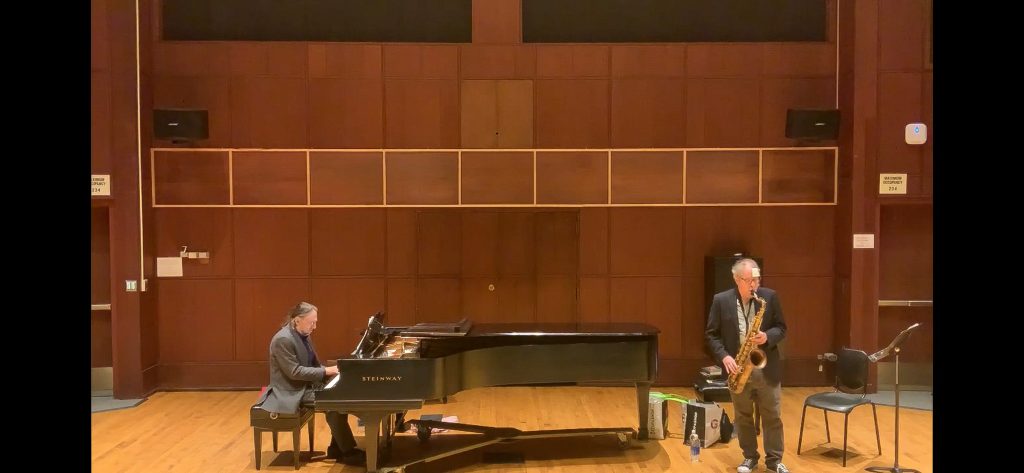Last Thursday night, a small crowd of students, community members and musicians filed into Casadesus Recital Hall. Hugs were shared, seats were found and Jonathan Karp, associate professor and undergraduate director of Judaic studies at Binghamton University, introduced the first installment of a three-part series called “Jewish Encounters With Jazz: International Perspectives.”
The event attempts to illuminate the history of Judaism and jazz in the United States through both lecture-style speaking and live jazz performance. To expand to an international perspective, the following events in the series will be the showing of a film called “The Jews and the Blues,” addressing the impact of jazz in Israel, as well as a lecture on Jews and jazz in Soviet Russia entitled “How they Swung in Odessa: Jews and the Birth of Soviet Jazz.”
At the start of the concert, the room held emotional weight as Karp called to mind the tensions and difficulties of the past week for the Jewish community.
“I think we’re all reeling from the horrific reports and images from Israel,” Karp said. “It’s my hope that tonight’s event, which has been long in the planning, will offer some momentary and needed respite.”
After this acknowledgment, Karp introduced the two speaker-performers of the event, Allen Lowe and Lewis Porter. Lowe, on saxophone, was Artist of the Year in 2021 for the Jazz Times Readers’ Poll and has written multiple books and essays on jazz history. Porter, on piano, teaches Jazz Studies at Rutgers University and has written biographies for jazz greats John Coltrane and Lester Young. Karp noted that both speakers are not only incredibly well-versed and insightful scholars in the realm of jazz history but also talented performers.
This proved true as Lowe and Porter pontificated, improvised and jested with each other throughout the night.
“We don’t necessarily agree upon everything,” Porter said. “But hey, I just told you, we’re Jewish. The point isn’t agreement. The point is interesting, different points of view.”
Porter noted that Jewish musicians are overrepresented in jazz in terms of non-Black players, composers and historians. Between various songs and crash courses on jazz history, Lowe and Porter attempted to explain this phenomenon. They postulated that the Jewish fascination with the art form may have come from the cantorial tradition, as well as the fact that the sheer beauty and counter-culture of the art form could appeal to Jews struggling with identity in the United States, albeit in different ways and to different degrees.
David Floyd, chief cataloging librarian for Judaic studies at Binghamton, spoke to the importance of Lowe and Porter’s instrumental approach on a complex and sensitive topic, especially in relation to how Judaism interacts with the Black art form of jazz.
“I think trying to engage in a conversation about Jewishness and jazz is a big challenge, so I like that they chose to play most of the conversation,” Floyd said. “I think the selection was smart. I like it when a concert is just a museum piece, but there’s this integration of ‘half from the past, half from the present’ and people playing their own compositions.”
The musical element highlighted the blend of cultural influences, along with the touch of Lowe and Porter’s personal composition and adaptation of several songs from Black and Jewish composers, many of them show tunes. The music was raw and exaggerated, filling the room with exuberant energy.
After the performances, Porter responded to a question about how he and Lowe improvised jazz solos.
“This is the thing that always drives musicians crazy,” Porter said. “You’re improvising, so that means whatever goes, right?”
Porter proceeded to slam his arm on the piano discordantly.
“No, it’s not whatever goes,” Porter said. “It’s a discipline you study for years and years. I know a number of very accomplished classical musicians … They try to improvise jazz, and they sound like beginners.”
Famous Jewish jazz saxophonist Stan Getz came up in conversation a few times throughout the event. Karp further elaborated on Getz’s humility and uniqueness in his attempt to adapt Black jazz to his own art.
“[Getz] never failed to acknowledge his indebtedness to the great Black jazz masters from whom he learned,” Karp said. “That’s part of what made it possible for him to adapt the music to express his own identity. This is beautiful. What isn’t beautiful is what might be called cultural theft. That’s different. That’s the phenomenon of taking without acknowledging the debt and claiming full credit and reward for somebody else’s work.”
Porter and Lowe approached the topics of identity and appropriation with a depth of understanding, nuance and self-deprecating humor. Their vast knowledge and soulful performances had the audience consistently laughing, nodding their heads or tapping their feet.
At the end of the night, Karp asked Porter and Lowe to explain in a few words the reasons for their personal love for jazz as an art form.
“Tremendous warmth,” Porter said. “Very rich color. And really, imagination.”
Lowe delivered his response with just as much feeling.
“It’s just the smartest, most interesting creative art form I’ve ever seen,” Lowe said. “The great thing about jazz is that it serves as both an art form and entertainment, and you rarely find any form that is so profoundly good in both those areas.”



